German actor and director Charles Willy Kayser (1881-1942) had a remarkable career in silent cinema and co-starred with stars such as Asta Nielsen and Mia May. Today, many of his films are considered lost, and there is just little information about them.

German postcard by Verlag Hermann Leiser, Berlin-Wilm., no. 4359. Photo: Max Lutze.
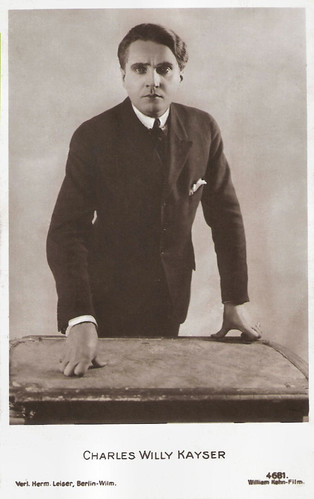
German postcard by Verlag Hermann Leiser, Berlin-Wilm., no. 4681. Photo: William Kahn-Film. Publicity still for Dämon der Welt. 1. Das Schicksal des Edgar Morton / Demon of the World, Part 1: The Fate of Edgar Morton (Rudolf Del Zopp, Siegfried Dessauer, 1919).
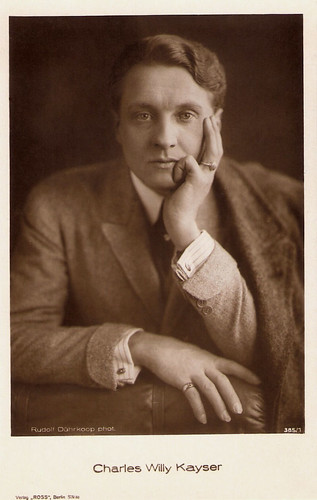
German postcard by Ross Verlag, Berlin, no. 385/1, 1919-1924. Photo: Rudolph Dührkoop Phot.

Former Yugoslav (Croatian) postcard by Jos. Caklovic, Zagreb, no. 35.

German postcard by Ross Verlag, no. 1281/2, 1927-1928. Photo: Atelier Hanni Schwarz.
Charles Wilhelm Kayser (sometimes written as Kaiser) was born in 1881 in Metz, part of the German Empire (now Moselle, France). He was the son of an officer who served in the French army and grew up with his sister Martel. At the age of 17, he went to the Conservatory of the Musikverein (Society of Friends of the Music) in Vienna against the wishes of his parents. There, he had vocal training.
The 18-year-old had his stage debut in 1898 at the Hamburger Opera Ensemble as a lyric baritone in 'The Bivouac of Granada'. In 1899, the Jeune premier made his stage debut in Berlin. In Vienna, Kaiser was a guest actor at the opera house and a company member of the Raimund Theater. He also performed in Karlsbad, Breslau, New York and Amsterdam. Between 1911 and 1914, Kayser worked at the renowned Burgtheater in Vienna.
In 1914, he moved to Riga, at the time part of the Russian Empire (now Latvia), where he became the head of the German Lustspielhaus. The outbreak of World War 1 at the end of July 1914 was a turning point in Kayser’s career. In August 1914, he was arrested by the Russian authorities for alleged espionage activities and, together with his wife, Betty abducted to Siberia in the Vyatka Governorate. Only after four years of suffering, he managed to escape with the help of the Swedish Red Cross.
Kaiser made his way back to Germany and arrived in Berlin completely without funds. There, he received a commitment at the Lustspielhaus. About the same time, the film career of the now over-35-year-old actor began. Among his first films were the silent dramas Sei getreu bis in den Tod / Be True to Death (Josef Stein, 1918) with Hanni Weisse, and Der siebente Kuß / The Seventh Kiss (Marie Luise Droop, 1918) with Hilde Wörner.
He also directed a few films, Die Autofahrt unter der Erde / The Car Ride under the Ground (1920), Tschetschensen-Rache / Chechen Revenge (1920), Im Fasching der Sinne / In the Carnival of the Senses (1920) and Tanz der Leidenschaften / Dance of Passions (1921).
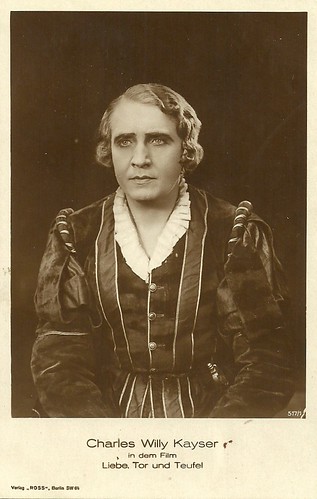
German postcard by Ross Verlag, no. 517/1, 1919-1924. Photo: publicity still for Liebe, Tor und Teufel / Love, Gate and Devil (Adolf Wenter, 1922).

German postcard by Ross Verlag, Berlin, no. 517/2. Charles Willy Kayser in Liebe, Tor und Teufel / Love, Gate and Devil (Adolf Wenter, 1922). The film was produced by the Munich-based company Orbis. Kayser's co-star was Margarete Schlegel. It would be remade in the 1930s and the 1950s.
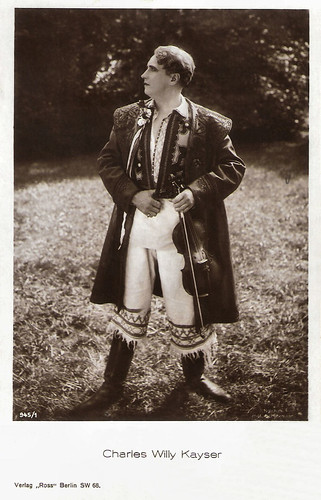
German postcard by Ross Verlag, no. 945/1. Photo: Schuhmann / Noto-Film. Publicity still for Die blonde Geisha / The Blonde Geisha (Ludwig Czerny, 1923).
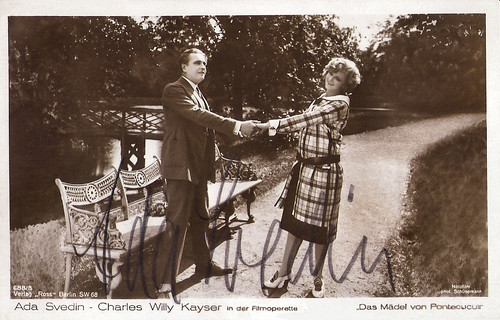
German postcard by Ross Verlag, no. 688/5, 1919-1924. Photo: Noto-Film / Schünemann. Publicity still for the silent operetta film Das Mädel von Pontecuculi / The Girl from Pontocuculi (Ludwig Czerny, 1924) with Ada Svedin.
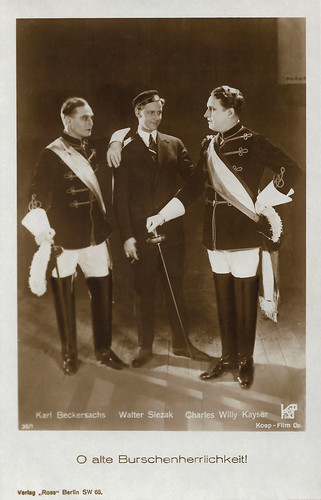
German postcard by Ross Verlag, no. 35/1. Photo: Koop-Film Co. Karl Beckersachs, Walter Slezak and Charles Willy Kayser in O alte Burschenherrlichkeit / Oh Those Glorious Old Student Days (Helene Lackner, Eugen Rex, 1925).
Charles Willy Kayser became a highly diverse, multi-faceted film actor. He appeared in such genres as crime films and melodramas, which were very popular in those years. He often played people of rank, including officers, princes, or counts, but among his characters are also villagers and detectives. His early films include the Mia May vehicle Fräulein Zahnarzt / Miss Dentist (Joe May, 1919), as the fiancé of the heroine. With Mia May, he also appeared in the comedy Der Amönenhof / The Amönenhof (Uwe Jens Krafft, 1920) as Count Leo von Zimburg.
In the melodrama Va banque/The Winner (Léo Lasko, 1920), he played a gambler, and in the drama Der ewige Fluch / The Eternal Curse (Fritz Wendhausen, 1921), he was sailor Jan Graat. Especially in the years 1920-1924, Kayser appeared in countless silent films. He played officers in Die elf schillschen Offiziere / Eleven Who Were Loyal (Rudolf Meinert, 1926) and Unsere Emden / Our Emden (Louis Ralph, 1926).
He played at the side of Asta Nielsen in the drug drama Laster der Menschheit/Vices of Mankind (Rudolf Meinert, 1927). He also appeared in Karl Grune's monumental historical film Waterloo (1927) as King Friedrich Wilhelm III opposite Charles Vanel as Napoleon. One of his last silent films was the thriller Masken/Masks (Rudolf Meinert, 1929) from the Stuart Webbs crime film series. Alongside Karl Ludwig Diehl as Stuart Webbs, Kayser appeared as banker Clifford, who was involved in a mysterious attack.
From 1926 to 1936, the Charles-Willy-Kayser-Lichtspiele cinema was located at Gasteiner Straße 26 in Berlin. Kayser operated three cinemas, including the Astoria Theatre at Potsdamer Straße 89. In 1928-1929, Kayser taught acting at the German Film School in Munich. After the arrival of sound film, Kayser played mainly small supporting roles. His last screen appearances were in the propaganda films Venus vor Gericht / Venus in Court (Hans H. Zerlett, 1941) and Kameraden / Comrades (Hans Schweikart, 1941).
Despite his poor health - he suffered from hypertension - he had been forced by the Nazis to continue to work as an actor. After an appearance in the Baltic Sea resort Ahlbeck, he broke down, suffered a cerebral haemorrhage and died the following day in a hospital in Berlin. Charles Willy Kayser was married to Betty Szalok, an opera singer from Hungary, with whom he had a daughter, Vera. Shortly after the death of Betty Szalok in 1938, Kayser gave the yes-word to a 30-year-younger artist, Ruth Sersen. Their daughter Gabriella, named Gaby, had already been born in Munich in 1929.

German postcard by Ross Verlag, Berlin, no. 35/2. Photo: Koop-Film Co. Karl Beckersachs, Charles Willy Kayser, Maria Zelenka, and Walter Slezak in O alte Burschenherrlichkeit! / Oh Those Glorious Old Student Days (Helene Lackner, Eugen Rex, 1925).

German postcard by Photochemie, Berlin, no. K. 3337. Photo: Rembrandt, Berlin.
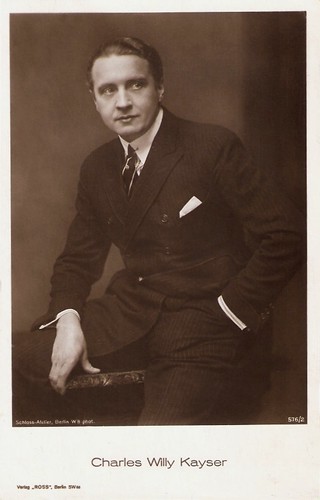
German postcard by Ross Verlag, Berlin, no. 576/2, 1919-1924. Photo: Schloss Atelier, Berlin.
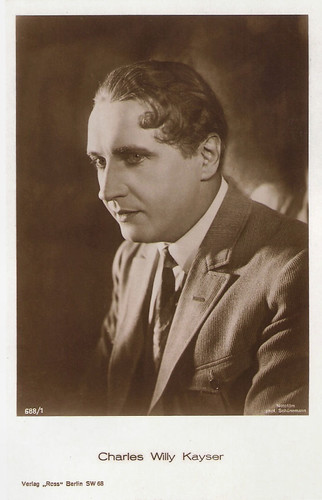
German postcard by Ross Verlag, Berlin, no. 688/1, 1919-1924. Photo: Notofilm / Schünemann.
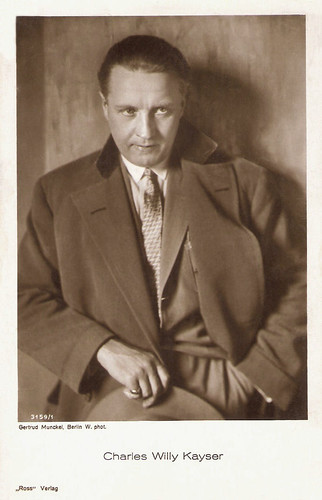
German postcard by Ross Verlag, Berlin, no. 3159/1, 1928-1929. Photo: Gertrud Munckel, Berlin.
Sources: Stephanie D’heil (Steffi-line - German), Thomas Staedeli (Cyranos - German), Wikipedia (German) and IMDb.
This post was last updated on 31 August 2025.

German postcard by Verlag Hermann Leiser, Berlin-Wilm., no. 4359. Photo: Max Lutze.

German postcard by Verlag Hermann Leiser, Berlin-Wilm., no. 4681. Photo: William Kahn-Film. Publicity still for Dämon der Welt. 1. Das Schicksal des Edgar Morton / Demon of the World, Part 1: The Fate of Edgar Morton (Rudolf Del Zopp, Siegfried Dessauer, 1919).

German postcard by Ross Verlag, Berlin, no. 385/1, 1919-1924. Photo: Rudolph Dührkoop Phot.

Former Yugoslav (Croatian) postcard by Jos. Caklovic, Zagreb, no. 35.

German postcard by Ross Verlag, no. 1281/2, 1927-1928. Photo: Atelier Hanni Schwarz.
Arrested for alleged espionage activities
Charles Wilhelm Kayser (sometimes written as Kaiser) was born in 1881 in Metz, part of the German Empire (now Moselle, France). He was the son of an officer who served in the French army and grew up with his sister Martel. At the age of 17, he went to the Conservatory of the Musikverein (Society of Friends of the Music) in Vienna against the wishes of his parents. There, he had vocal training.
The 18-year-old had his stage debut in 1898 at the Hamburger Opera Ensemble as a lyric baritone in 'The Bivouac of Granada'. In 1899, the Jeune premier made his stage debut in Berlin. In Vienna, Kaiser was a guest actor at the opera house and a company member of the Raimund Theater. He also performed in Karlsbad, Breslau, New York and Amsterdam. Between 1911 and 1914, Kayser worked at the renowned Burgtheater in Vienna.
In 1914, he moved to Riga, at the time part of the Russian Empire (now Latvia), where he became the head of the German Lustspielhaus. The outbreak of World War 1 at the end of July 1914 was a turning point in Kayser’s career. In August 1914, he was arrested by the Russian authorities for alleged espionage activities and, together with his wife, Betty abducted to Siberia in the Vyatka Governorate. Only after four years of suffering, he managed to escape with the help of the Swedish Red Cross.
Kaiser made his way back to Germany and arrived in Berlin completely without funds. There, he received a commitment at the Lustspielhaus. About the same time, the film career of the now over-35-year-old actor began. Among his first films were the silent dramas Sei getreu bis in den Tod / Be True to Death (Josef Stein, 1918) with Hanni Weisse, and Der siebente Kuß / The Seventh Kiss (Marie Luise Droop, 1918) with Hilde Wörner.
He also directed a few films, Die Autofahrt unter der Erde / The Car Ride under the Ground (1920), Tschetschensen-Rache / Chechen Revenge (1920), Im Fasching der Sinne / In the Carnival of the Senses (1920) and Tanz der Leidenschaften / Dance of Passions (1921).

German postcard by Ross Verlag, no. 517/1, 1919-1924. Photo: publicity still for Liebe, Tor und Teufel / Love, Gate and Devil (Adolf Wenter, 1922).

German postcard by Ross Verlag, Berlin, no. 517/2. Charles Willy Kayser in Liebe, Tor und Teufel / Love, Gate and Devil (Adolf Wenter, 1922). The film was produced by the Munich-based company Orbis. Kayser's co-star was Margarete Schlegel. It would be remade in the 1930s and the 1950s.

German postcard by Ross Verlag, no. 945/1. Photo: Schuhmann / Noto-Film. Publicity still for Die blonde Geisha / The Blonde Geisha (Ludwig Czerny, 1923).

German postcard by Ross Verlag, no. 688/5, 1919-1924. Photo: Noto-Film / Schünemann. Publicity still for the silent operetta film Das Mädel von Pontecuculi / The Girl from Pontocuculi (Ludwig Czerny, 1924) with Ada Svedin.

German postcard by Ross Verlag, no. 35/1. Photo: Koop-Film Co. Karl Beckersachs, Walter Slezak and Charles Willy Kayser in O alte Burschenherrlichkeit / Oh Those Glorious Old Student Days (Helene Lackner, Eugen Rex, 1925).
A highly diverse, multi-faceted film actor
Charles Willy Kayser became a highly diverse, multi-faceted film actor. He appeared in such genres as crime films and melodramas, which were very popular in those years. He often played people of rank, including officers, princes, or counts, but among his characters are also villagers and detectives. His early films include the Mia May vehicle Fräulein Zahnarzt / Miss Dentist (Joe May, 1919), as the fiancé of the heroine. With Mia May, he also appeared in the comedy Der Amönenhof / The Amönenhof (Uwe Jens Krafft, 1920) as Count Leo von Zimburg.
In the melodrama Va banque/The Winner (Léo Lasko, 1920), he played a gambler, and in the drama Der ewige Fluch / The Eternal Curse (Fritz Wendhausen, 1921), he was sailor Jan Graat. Especially in the years 1920-1924, Kayser appeared in countless silent films. He played officers in Die elf schillschen Offiziere / Eleven Who Were Loyal (Rudolf Meinert, 1926) and Unsere Emden / Our Emden (Louis Ralph, 1926).
He played at the side of Asta Nielsen in the drug drama Laster der Menschheit/Vices of Mankind (Rudolf Meinert, 1927). He also appeared in Karl Grune's monumental historical film Waterloo (1927) as King Friedrich Wilhelm III opposite Charles Vanel as Napoleon. One of his last silent films was the thriller Masken/Masks (Rudolf Meinert, 1929) from the Stuart Webbs crime film series. Alongside Karl Ludwig Diehl as Stuart Webbs, Kayser appeared as banker Clifford, who was involved in a mysterious attack.
From 1926 to 1936, the Charles-Willy-Kayser-Lichtspiele cinema was located at Gasteiner Straße 26 in Berlin. Kayser operated three cinemas, including the Astoria Theatre at Potsdamer Straße 89. In 1928-1929, Kayser taught acting at the German Film School in Munich. After the arrival of sound film, Kayser played mainly small supporting roles. His last screen appearances were in the propaganda films Venus vor Gericht / Venus in Court (Hans H. Zerlett, 1941) and Kameraden / Comrades (Hans Schweikart, 1941).
Despite his poor health - he suffered from hypertension - he had been forced by the Nazis to continue to work as an actor. After an appearance in the Baltic Sea resort Ahlbeck, he broke down, suffered a cerebral haemorrhage and died the following day in a hospital in Berlin. Charles Willy Kayser was married to Betty Szalok, an opera singer from Hungary, with whom he had a daughter, Vera. Shortly after the death of Betty Szalok in 1938, Kayser gave the yes-word to a 30-year-younger artist, Ruth Sersen. Their daughter Gabriella, named Gaby, had already been born in Munich in 1929.

German postcard by Ross Verlag, Berlin, no. 35/2. Photo: Koop-Film Co. Karl Beckersachs, Charles Willy Kayser, Maria Zelenka, and Walter Slezak in O alte Burschenherrlichkeit! / Oh Those Glorious Old Student Days (Helene Lackner, Eugen Rex, 1925).

German postcard by Photochemie, Berlin, no. K. 3337. Photo: Rembrandt, Berlin.

German postcard by Ross Verlag, Berlin, no. 576/2, 1919-1924. Photo: Schloss Atelier, Berlin.

German postcard by Ross Verlag, Berlin, no. 688/1, 1919-1924. Photo: Notofilm / Schünemann.

German postcard by Ross Verlag, Berlin, no. 3159/1, 1928-1929. Photo: Gertrud Munckel, Berlin.
Sources: Stephanie D’heil (Steffi-line - German), Thomas Staedeli (Cyranos - German), Wikipedia (German) and IMDb.
This post was last updated on 31 August 2025.
No comments:
Post a Comment